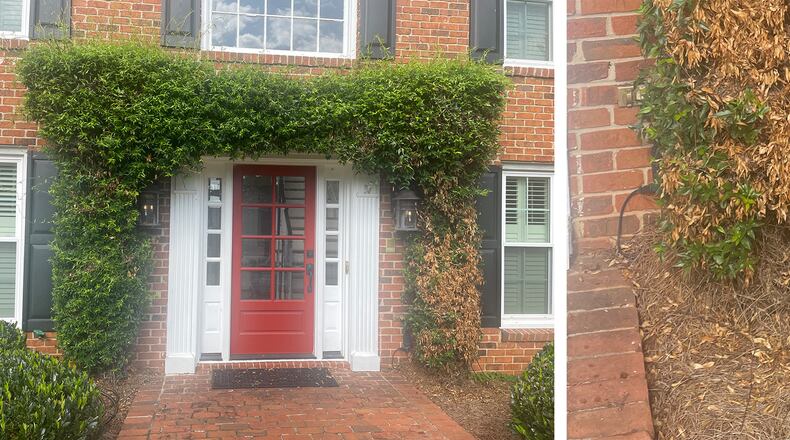Q: We have a Confederate jasmine vine growing up both sides and over our front door. Part is dying on one side, and would like to arrest that ASAP. Can you diagnose anything from my photos? John McCutcheon, Smoke Rise
A: Hmmmmmmm ... I don’t think it is a disease. I don’t see any fungal or bacterial spots on the leaves. Honestly, it looks like one of the stems coming from the ground has suffered unseen damage that led to blocking the sap traveling to everything connected to the vine above. I noticed the electric outlet behind the base of the vine. Could you have snapped a stem while wrestling with a recalcitrant plug? Was any damage done while installing Christmas lights?
For repair, I’d start by pulling off all of the brown leaves. They will not turn green again. Then, starting at the bottom, try to follow the afflicted vine stem upward. When you reach 2 feet, take off some small stems and snap them. If they’re brown and dry, it likely means everything above that point is brown and dry. That part of the whole green vine is dead; there is no reason to remove it. But don’t despair: The rest of the vine looks green and healthy. Water occasionally and mix some Osmocote into the soil, going out about 2 feet, and you’ll give the remaining green vine great impetus to grow and fill in the openings the brown-leafed vine once occupied.
Q: I have several pecan trees, and for the last two years, they have dropped their nuts early before they have matured. I was wondering what causes this and what I can do about it. James Sease, email
A: Your pecan has scab disease. Our heat and high humidity make conditions perfect for this fungal disease to develop. Unfortunately, homeowner control is well nigh impossible. Pecan farmers have huge blowers that spray fungicide to the top of their trees. Complete coverage is imperative to stop infection. So what is left for you to do? Rake up and remove fallen leaves and infected pecans regularly, spring through fall. That’s it; this is the best suggestion I have. If you have a dry spring, you may have a great pecan crop. Wet and warm springs may result in no edible pecans at all. If you have the opportunity to plant new trees, plant scab-resistant varieties like ‘Stuart,’ ‘Elliott,’ ‘Curtis,’ and ‘Gloria Grande.’ Even if you spot disease in a tree, it is important to keep it healthy otherwise. Have a soil test done (georgiasoiltest.com) and follow fertilizer and lime recommendations exactly.
Email Walter at georgiagardener@yahoo.com. Listen to his occasional garden comments on “Green and Growing with Ashley Frasca” Saturday mornings on 95.5 WSB. Visit his website, www.walterreeves.com, or join his Facebook page at bit.ly/georgiagardener for his latest tips.
About the Author
The Latest
Featured

